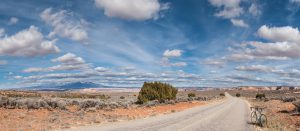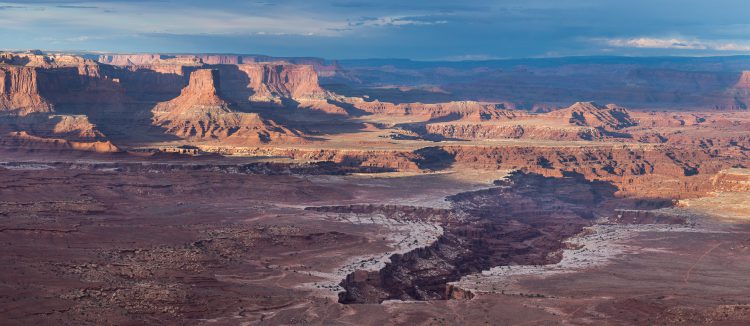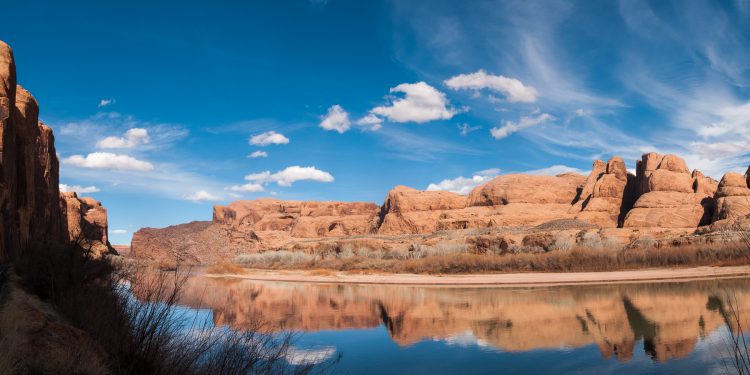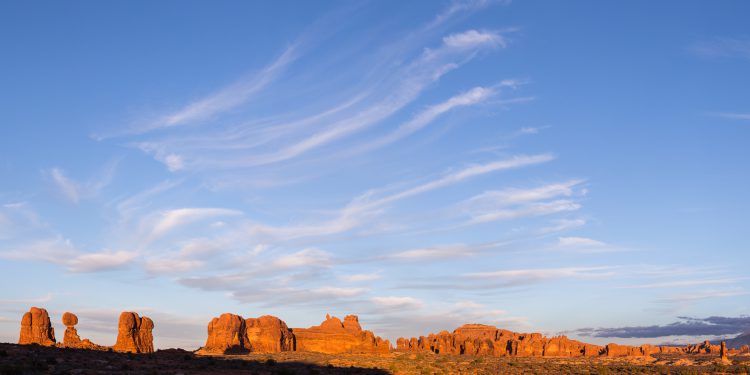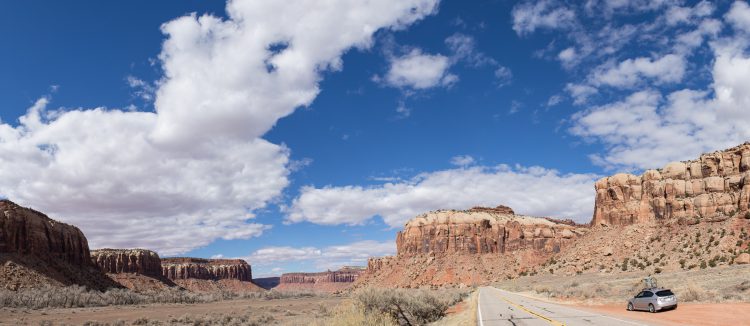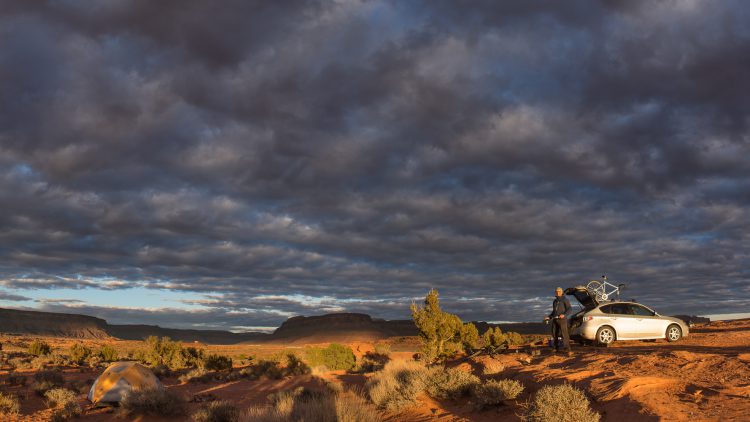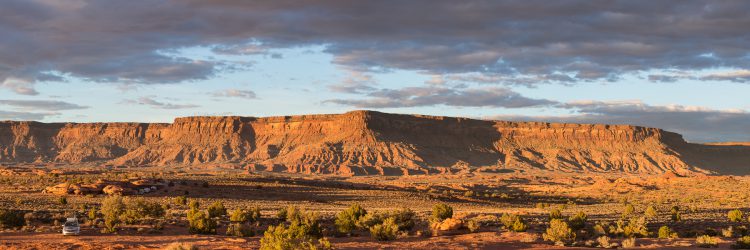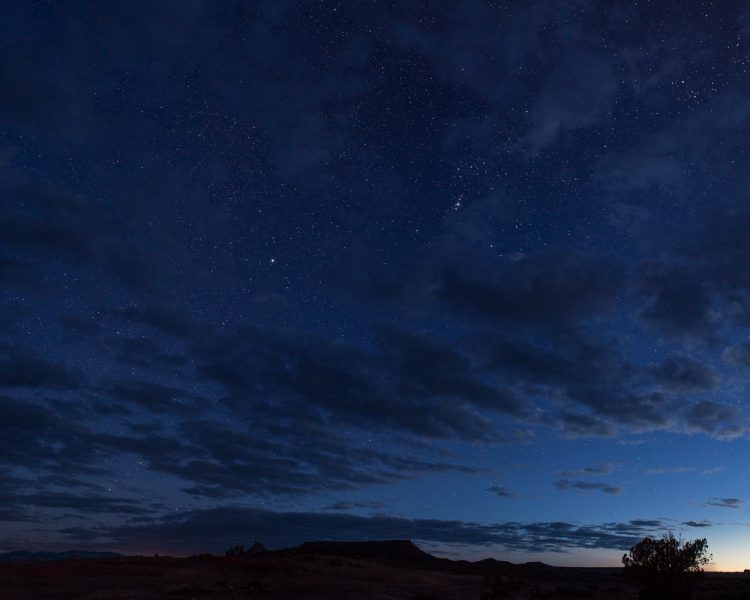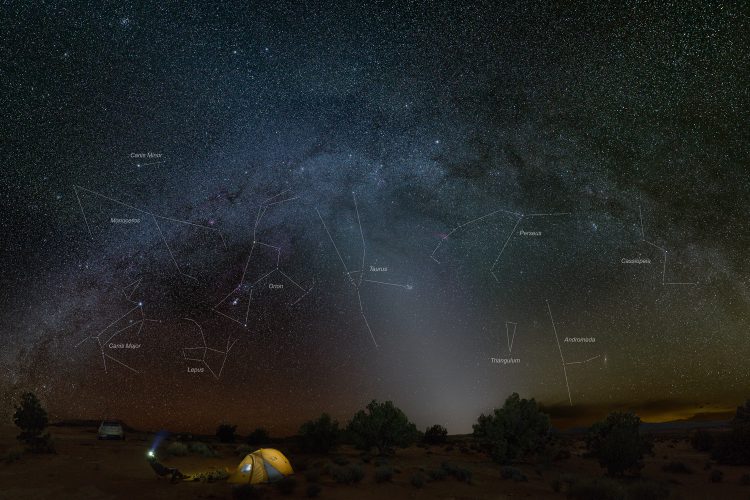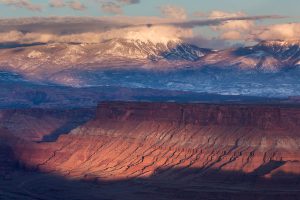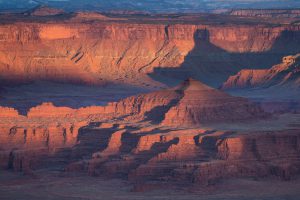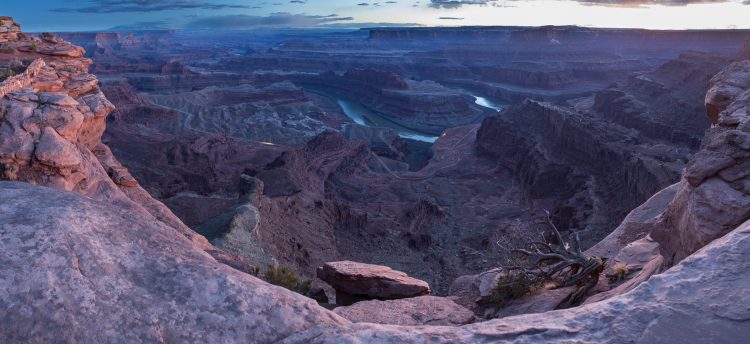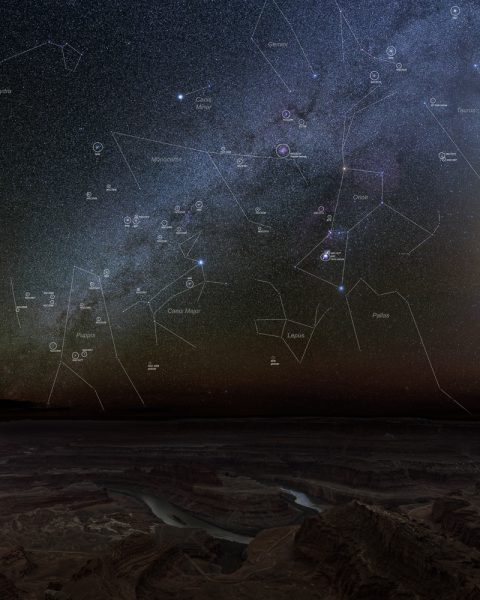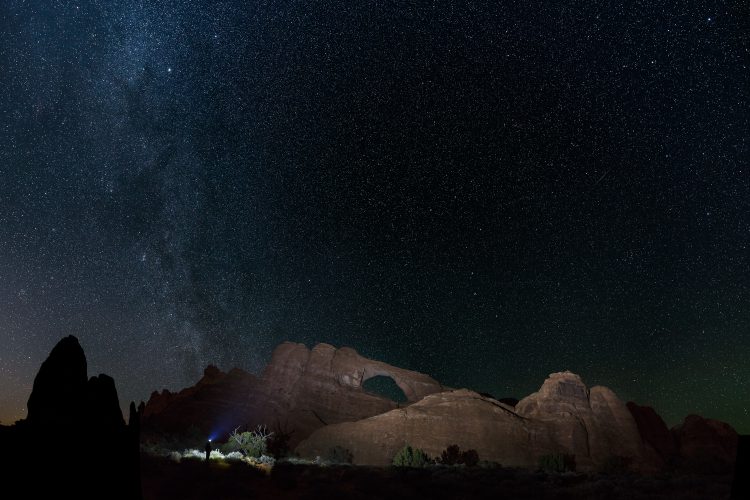Leaving Canada and driving for two days down I15 through the rugged, big sky country of Montana and Idaho, I had plenty of time to ponder what it is about the desert environment, in general, and Utah, in particular, that keeps bringing me back.
There is certainly no shortage of adventure possibilities, including bike touring across the mountains, backpacking through the desert, and river trips through the canyons. And all manner of fun day trips, including mountain biking, road riding, climbing, paddling and hiking.
But what keeps me coming back is simple.
Raw beauty.
Ultimately, the dramatic geology and rugged environment of the place is just achingly beautiful. The contrast of red rock against deep blue skies. The tenacious juniper trees that survive and thrive while rooted only in a sandstone crack. The rivers that have flowed for millions of years, carving through well over 600m of rock, and created vast canyons with towering sandstone walls. The La Sal mountains that rise to 12,000 feet, trap passing weather, and stand guard over the canyons and mesas in all directions.
Dramatic skies
March in Moab is just the beginning of spring, and the trees and shrubs still have the bare branches of winter. Temperatures drop to freezing at night and rise to between 15 and 20C during the day, and rain or even snow storms happen.
And whether the sky is clear blue or full of clouds, it rarely disappoints. When thunderstorms are building, the sky is filled with dramatic cumulus clouds that can rapidly break apart into wisps of vapour. When the clouds are more stubborn they still manage to have texture that adds drama to an already primal and powerful landscape.
And when the sun pokes through holes in an overcast sky, the resulting play of light on the land is absolutely breathtaking.
During the more turbulent spring season, in between storms there are often sprays of thin cirrus clouds that provide a delicate canvas for the sun to paint.
Dark skies
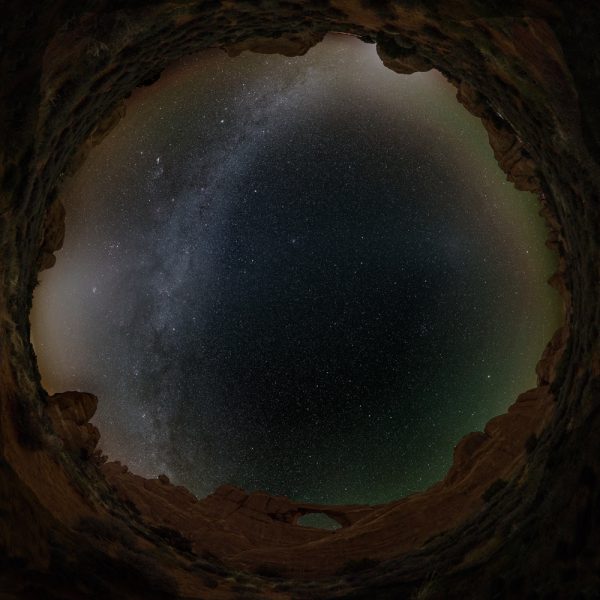
All-sky view of Skyline Arch, Arches National Park. North is down, west is left and east is right in this image.
Because the US south west desert is a vast and relatively harsh land, it is one of the few remaining places where you can get far from the artificial lights of human civilization that inevitably accompany us wherever we go.
The light pollution resulting from our constant need for illumination as we spread into every corner of the globe has, among other things, deprived most of humanity of something that was a constant in our lives for 1000s of years: night skies thick with stars. Well over half of humanity now lives in cities, where you can typically see fewer than 100 stars. In many countries, that urban population is between 80-100% and growing.

Light pollution map of North America, by DarkSkyFinder.com
The stars were the foundation for much of ancient mythology, in most cultures, and all the brightest stars have official names, most of them dating back 100s or 1000s of years and originating from Arabic, Greek or Latin. The northern constellation names in English mostly come from Greek Mythology, and in winter the most famous constellation is Orion, the hunter, who was placed in the sky by the god Zeus. He is accompanied by hunting companions Canis Major and Minor, the big dog and the little dog.
This ancient connection with the Universe, and the deep history of astronomy across many cultures, is being lost as people increasingly live urban, online and indoor lives. However, the vast desert regions of the Colorado Plateau are one of the few remaining areas where the sky is still dark and the Universe open to exploration!
Indian Creek
Late March is pretty much the end of the season to observe the winter night sky, when the constellations of Canis Major (the dog), Orion (the hunter), Taurus (the bull) and Lepus (the rabbit) form a fanciful hunting scene in the sky.
I timed this trip to coincide with the week before new moon, so that the night skies would be as dark as possible. March, however, is a season of turbulent weather, even here in the desert, and with a forecast for storms the next few days I take the first good weather opportunity to head south from the town of Moab and camp under some really dark skies.
Leaving town on Tuesday the forecast is for a cloudy afternoon but a clear evening, and driving west along highway 211 through the big walls of Indian Creek the cumulus clouds cover half the sky. The scenery is still stunning, as the sun lights up the towering sandstone walls and vast landscape in a patchwork of light and shadow.
Despite being early in the season, the three campsites that I explore are either full or closed. After finally finding a spot and setting up camp, there is not time anymore for an afternoon ride, the sky has filled with clouds from horizon to horizon, and my hopes for a starry night are dwindling. There is a band of clear sky beneath the clouds in the west, however, and when the sun drops into that clearing it lights up the surrounding cliffs of Navajo sandstone with breathtaking results. Even if there is no star gazing tonight it was worth coming out here to experience that sunset!
Dinner was interrupted by the spectacular light show of sunset, and after running around shooting the landscape like crazy for a magical half hour, my pasta needs re-heating and is then finished under a darkening sky. Remarkably, the puffy clouds are breaking up and the stars are poking through! It’s a beautiful sight, the weather forecast is proving accurate, and my hopes rise again for the sky to clear enough for star gazing tonight.
Within an hour, the clouds have disappeared and the stars are blazing in the dark sky. Fantastic! One of the main reasons I came down to Moab is to capture the winter night sky, and while there is certainly no shortage of night sky in Canada during the long, dark winter, there’s one major problem: it’s bloody cold star gazing up north! Standing around in -20C, or even -10, for hours while fiddling with tiny buttons on the camera is… not as much fun as it sounds. And while desert nights are still cold, they are not Canada-cold!
One horse, two guys, two women, a big dog and a little dog, a rabbit, a bull, and… a triangle make up the ancient constellations of the winter sky, some of which require creative extrapolation to visualize. Above these constellations, the Milky Way arches from south (left) to north-west (right).
Clearly visible in this image is a bright band reaching up from the horizon between Taurus and Perseus. This is the Zodiacal Light, caused by Sun light reflecting off dust particles scattered through our solar system. All the (major) planets orbit the sun in a disk called the ecliptic plane, and most of the dust particles orbit the sun in the same plane. These dust particles are mostly thought to originate from comet fragments as well as collisions of asteroids.
While the Zodiacal Light is an interesting phenomenon that illustrates the ecliptic plane and demonstrates the mechanics of our solar system, it is a nuisance to astro photography because it’s bright enough to wash out even bright objects like the Pleiades.
Dead Horse Point State Park
After leaving Indian Creek, the weather turned stormy for a couple days, and on Saturday it was cold, near freezing, and raining overnight. By Sunday morning around 9 the rain had changed to snow, and big, fluffy flakes filled the sky until mid morning; a good day to do some laundry and get groceries. The weather forecast called for the sky to clear in the evening, but all afternoon the clouds are still heavy and gray and I’m not excited about photography.
Right on schedule at 5pm a hint of blue appears in the western sky and I scramble to get on the road to capture sunset, this time aiming for Canyonlands National Park. The sky is clearing very quickly, changing from a heavy gray blanket of clouds to mostly clear in about one hour!
By the time I get up towards Canyonlands there are still clouds over the La Sal mountains, and the sun is setting quickly, so at the last minute I decide to head east to Dead Horse Point state park, which is a bit closer than Islands in the Sky in Canyonlands, and get there with just minutes of magical light remaining.
Walking around the rim in the gorgeous but chilly evening twilight, I find a spot on the edge of the canyon with a great view down to the White Rim and the Colorado River far below. This is a scene that I’ve been wanting to capture ever since I first visited Dead Horse State Park, more than 10 years ago. The park is high (1800m), remote (48km from Moab, the nearest town), has stunning views to the south, east and west, and in 2016 received certification as a Dark Sky Park by the International Dark-Sky Association.
After sunset the sky continues to clear, the stars come out crisp and bright, without a hint of moisture-induced haze to obscure them. The wet and stormy day has turned into a stunning, clear night, just as forecast. The sky continues to darken, and the air temperature quickly drops to around freezing.
Click to zoom into the high-resolution image.
With perfect sky conditions at this stunning location, it’s well worth freezing in the dark at the edge of a cliff for a few hours while the camera opens for two minutes at a time, capturing photons that have been sailing across the cosmos for 1000s of years, and happen to land exactly here. Despite the bright stars, it is too dark to see down into the vast canyon, just a couple meters in front of the camera, but I can feel the tremendous void in the darkness.
This image was built up from 25 frames, 2-minute exposure each, taken with a 50mm lens at f2.8. Within it are 12 of the famous Messier objects: star clusters M35, M37, M41, M46, M47, M48, M50, M93, nebulae M1, M42, M72, globular cluster M79; and well over 30 NGC objects, mostly star clusters. The brightest star (lower centre-left) is Sirius, and the Orion constellation is at centre-right.
Most of the star clusters are located along the bright band of the Milky Way, swooping from lower-left to upper-right. The dimly glowing red patches are nebulous clouds of interstellar hydrogen gas that have been ionized by bright, hot, nearby stars.
Stars are created when vast clouds of interstellar gas undergo gravitational collapse. These clouds are vast, usually cold, and extremely low density – from one atom to thousands of atoms per cubic centimeter. By comparison, what is considered an “ultra high vacuum” here on Earth contains over 1,000,000,000 molecules per cm3. Despite this low density, because these clouds are so big, they block the light of stars behind them, and can be seen in the image as dark bands running through the thick mass of stars in the Milky Way.
As the clouds collapse, the denser regions attract more gas, and as more gas falls in, the pressure and temperature can rise to the point where nuclear fusion ignites the hydrogen, and a star is born! Most often, 100s of stars of all different sizes are created at roughly the same time (within one million years) as an immense gas cloud collapses. The largest and brightest stars in the cloud throw off incredible amounts of light and particles (solar wind), illuminating, ionizing and eroding the gas that still surrounds them.

Orion Nebula. Credit: JBNightSky.com
The closest of these star-forming regions is in the constellation Orion, and is visible as the third “star” on Orion’s sword. The Orion Nebula contains approximately 700 stars, in various stages of formation, and recent observations by the Hubble Space Telescope have discovered over 150 not-yet-formed solar systems around some of these stars. These dense disks of gas, called protoplanetary disks, or proplyds, are in the process of collapsing to form planets around a young star.
The largest stars in new star-forming region consume their gas at a ferocious rate, fusing lighter elements into heavier ones, and only surviving a few million years before exploding as supernovae. In addition to enriching the region with heavier elements like carbon, silicon, oxygen, nitrogen and most everything else we see and touch here on Earth, these supernova explosions also blow away most of the remaining gas in the nebula, ending the formation of new stars in their vicinity.
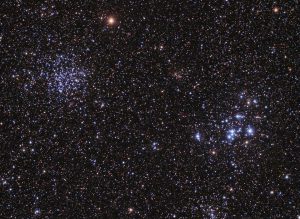
Star clusters M46 and M47. Image credit: Sergio Eguiva, Buenos Aires Skies .
What remains is a star cluster, a group of 100s of young stars and solar systems in a fairly tight clump, gravitationally bound together and moving through the Milky Way as a unit. Because these star clusters are young, they often contain large, bright stars that stand out against the rest of the stars in the greater region. Stellar gems!
The two-minute exposures capture much, much more than the human eye can see. Seeing the invisible – discovering what’s out there – is a big part of night photography!
In a really good dark-sky site like this one, we can see several thousand stars, perhaps 4000 or 5000, with the naked eye. Two-minute exposures capture a lot more, and there are perhaps 1-2 million stars visible in this high resolution image, which is only a tiny fraction of the 1 billion stars that the Gaia satellite is currently surveying, which is itself only around 1 percent of all the stars in our Milky Way galaxy.
It’s a big universe out there.
Arches National Park
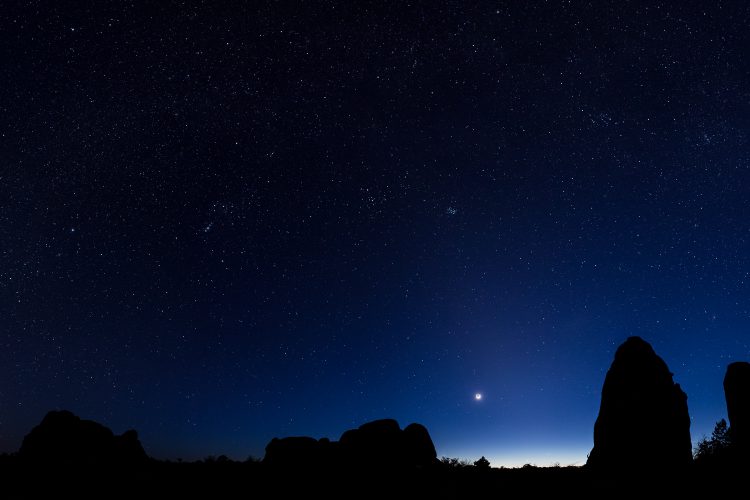
A thin crescent Moon, with Venus and Mercury just below it, all about to follow the sun below the horizon. Arches National Park.
The next morning was clear but cool and the sky was blue all day – a beautiful time to enjoy the desert! The new moon happened on Saturday, so now (Monday) the moon is trailing behind the sun, setting roughly one extra hour later than the sun every day.
After capturing the southern sky in Dead Horse Point, I’m planning to capture the northern sky this evening, with some cool-looking rocks in the foreground. There is no shortage of funky landscapes in Arches National Park to silhouette against the sky, and as sunset fades to twilight I just need to pick a spot.
Just after sunset the very thin crescent moon follows the sun towards the horizon, and the brightest planet, Venus, and the innermost planet, Mercury, are below the moon and just barely above the still-blue western horizon. To the south, the bright stars are easily visible in the darker sky.
Walking around at night surrounded by looming masses of dark, heavy stone is a little spooky. In the Fins area of Arches national park the rocks have been eroded into tall, smooth, rounded blobs and fins, and the trails wind between the fins, which tower above you as massive, dark shapes in the night. When it’s pitch black out you can’t really see them, but somehow you can sense their rounded bulk in the darkness.

Arches were formed as parallel fractures in the rock first eroded into fins, and then thinned over time. Illustration from National Parks Service.
The natural rock arches this region is famous for, and that this National Park was created to preserve, were created in several stages. First, the deeply buried sandstone was bent into an anticline (upside-down U shape) as a deeper salt bed rose because of it’s lower density, causing vertical fractures. The entire region was then slowly uplifted by tectonic forces and the overlying rock layers eroded away. The layers currently at the surface, fractured along the axis of the anticline, are being eroded, mostly by water, with weak fracture lines eroding quicker. The fins continue to erode, occasionally thinning to the point that an arch forms.
By the end of the week we have mostly clear evening skies again, but by now the moon is high in the sky and approaching half. The presence of the moon changes the character of night photography: the ability to capture “deep and dark sky” images is lost (well, becomes more difficult) because the sky is brightened by moon light, but the ground is now illuminated, making for more interesting landscapes. A half moon really illuminates the ground, casting clear shadows and giving the sky a distinct blue tint, similar to daylight.
Dear desert: I will return!
Darren Foltinek, March 2018




